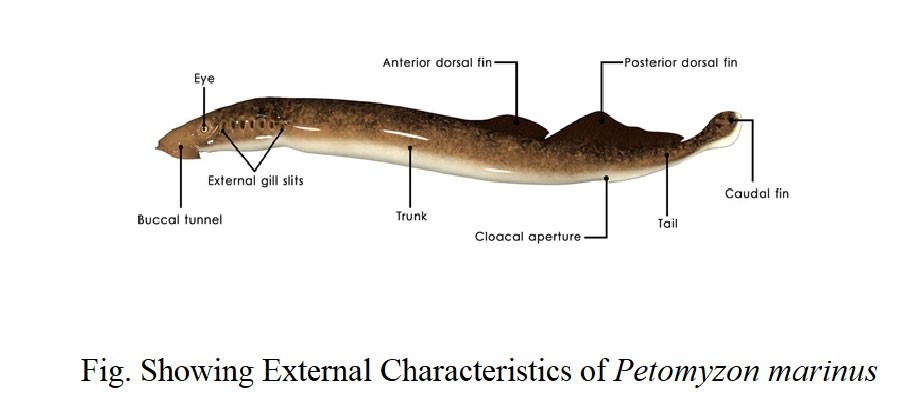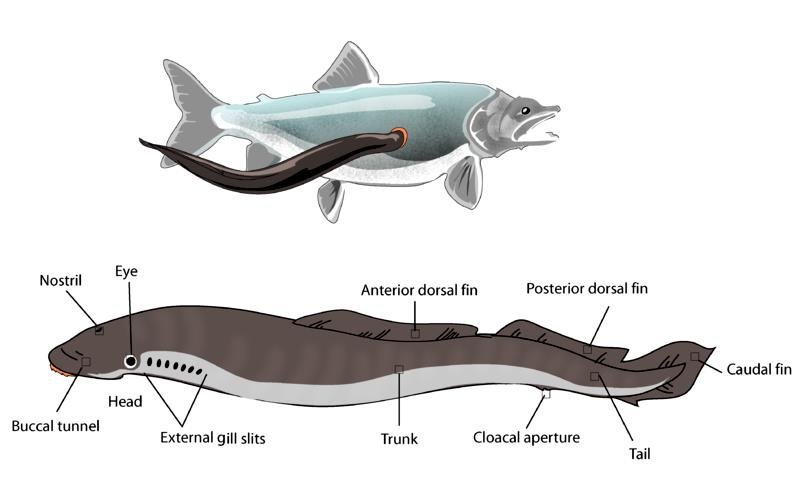Table of Contents
What is Petromyzon (Lamprey):
Lamprey is jawless fish like Vertebrate placed under Group Agnatha along with the Ostracoderm. At present-day among all the living Vertebrates, the lamprey is the most primitive Vertebrate and they have only one living class known as Cyclostomata, under Cyclostomata lamprey, Hagfish present. The term Cyclostomata refers to their circular mouth opening without jaw and teeth.
They are also known as circular mouth eels because their body appears like eels externally but they are not actually eeled because the actual eel has a jaw. Lamprey lives in freshwater as well as in marine water and their body size is generally large. For example, Petromyzon marinus live in marine water while Lampetra fluviotilis live in a freshwater environment.

Systematic Position of Lamprey:
Lamprey and Hagfish are known as Cyclostomes due to their jawless mouth opening, lamprey is of type Petromyzon, they are placed under family Petromyzonidae, under order Petromyzontiformes. Lamprey is placed underclass Cyclostomata, under Group Agatha (mouth does not have jaw), under Subphylum Vertebrata, under phylum Chordata.
Geographical Distribution of Lamprey:
Lamprey lives in almost all geographical areas but some species are only confined to specific regions. For example, sea lamprey or Petromyzon marinus live in the USA, Canada, North America, Europe, and Africa, three species are abundant in the temperate zone of the Northern hemisphere.
Habitats of Lamprey:
Lamprey is generally found in all types of aquatic environments, almost all parts of the world, they live in both freshwater environments as well as in marine environments.

Habits of Lamprey:
- The life cycle of lamprey have two distinct phases, larval phase and adult phase.
- The first phase larval phase known as Ammocoet larva which is a freshwater sedentary stage.
- The Ammocoet larva collect their food through filter feeding mechanism, they collect food from the aquatic environment they live, the microscopic organisms present in water is used as their food, so the Ammocoet larva is microphagus.
- The Ammocoet larva undergoes metamorphosis and turn into fish like adult stage.
- The adult lamprey live in marine environment and are parasitic on some other fish.
- The suctorial mouth of lamprey help them to remain attached to the body of other fishes, their rasping tongue remove the tissues of the host fish.
- Sometimes lamprey become so large number that their collective parasitism effect the fish populations badly.
- Adult lamprey are bottom deweller and they swim by their undulation movement of their body.
- Adult lamprey migrate to freshwater during reproduction season (autumn), they migrate to freshwater river and after spawn they die after spring.
- So it is clear that lamprey need to migrate during their reproductive period and after that they die.
- When lamprey live in marine water they collect and take food as much possible but when they reach at freshwater stream or river they stop eating.
- When they collect and take food in marine water, the excess amount of food molecules are stored in the form of subcutaneous fat.
- When they do not take any food in freshwater river then they become dependent on the reserved food as subcutaneous fat.
- The subcutaneous fat provide complete nutrition during their reproductive stage in river.
- Lamprey attain sexual maturity during winter and migrate to the river during autumn, during spring breeding occur.
- Lamprey show a peculiar type of nest building during their reproductive period in the river. Lamprey build a specific type of nest under the river, at river button lamprey build their nest in the sand and stone.
- So we now clear about it that, lamprey have two distinct phases of their life cycle and they live in different habitat in two different phases of their life.

Detailed Study On
Ostracodermi and its important Feature
Classification of Class Ostracodermi
Phylogeny of Subphylum Vertebrata
An Overview of Classification in Subphylum Vertebrata
Subphylum Vertebrata and its Diversity
Cephalochordata Characteristics Features Classification Examples and Diagram
Urochordata Classification Morphology Characteristic Features
Characteristics Features of Hemichordata
General Comparison of Hemichordata Urochordata and Cephalochordata
Comparative Study of Digestive System in Hemichordata Cephaochordata and Urochordata
Hi Everyone!!! Welcome to Imaluop. Imaluop always try to learn some new and he want to share to other people. Here we will try to learn various topics on Science, specially on Biological Sciences.